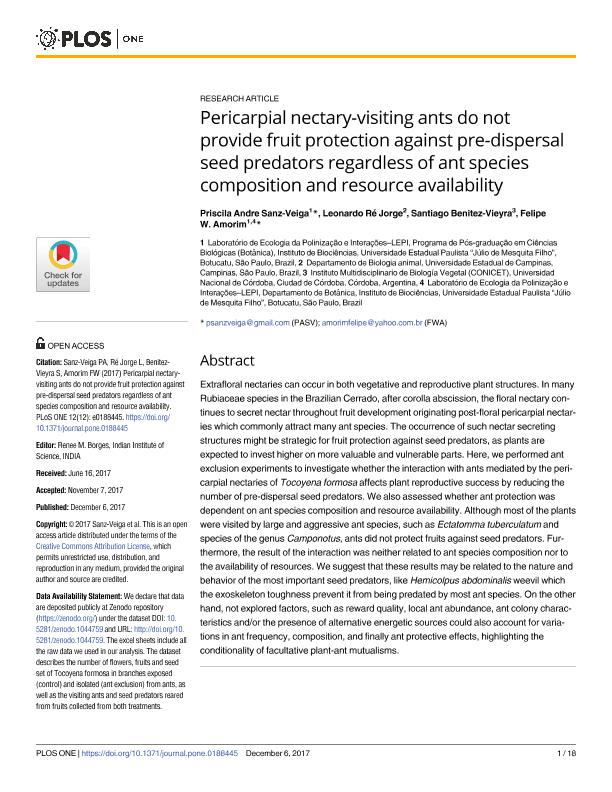Mostrar el registro sencillo del ítem
dc.contributor.author
Sanz-Veiga, Priscila Andre
dc.contributor.author
Ré Jorge, Leonardo
dc.contributor.author
Benitez-Vieyra, Santiago Miguel

dc.contributor.author
Amorim, Felipe W.
dc.date.available
2018-01-22T15:22:11Z
dc.date.issued
2017-12
dc.identifier.citation
Sanz-Veiga, Priscila Andre; Ré Jorge, Leonardo; Benitez-Vieyra, Santiago Miguel; Amorim, Felipe W.; Pericarpial nectary-visiting ants do not provide fruit protection against pre-dispersal seed predators regardless of ant species composition and resource availability; Public Library of Science; Plos One; 12; 12; 12-2017
dc.identifier.issn
1932-6203
dc.identifier.uri
http://hdl.handle.net/11336/34082
dc.description.abstract
Extrafloral nectaries can occur in both vegetative and reproductive plant structures. In many Rubiaceae species in the Brazilian Cerrado, after corolla abscission, the floral nectary continues to secret nectar throughout fruit development originating post-floral pericarpial nectaries which commonly attract many ant species. The occurrence of such nectar secreting structures might be strategic for fruit protection against seed predators, as plants are expected to invest higher on more valuable and vulnerable parts. Here, we performed ant exclusion experiments to investigate whether the interaction with ants mediated by the pericarpial nectaries of Tocoyena formosa affects plant reproductive success by reducing the number of pre-dispersal seed predators. We also assessed whether ant protection was dependent on ant species composition and resource availability. Although most of the plants were visited by large and aggressive ant species, such as Ectatomma tuberculatum and species of the genus Camponotus, ants did not protect fruits against seed predators. Furthermore, the result of the interaction was neither related to ant species composition nor to the availability of resources. We suggest that these results may be related to the nature and behavior of the most important seed predators, like Hemicolpus abdominalis weevil which the exoskeleton toughness prevent it from being predated by most ant species. On the other hand, not explored factors, such as reward quality, local ant abundance, ant colony characteristics and/or the presence of alternative energetic sources could also account for variations in ant frequency, composition, and finally ant protective effects, highlighting the conditionality of facultative plant-ant mutualisms.
dc.format
application/pdf
dc.language.iso
eng
dc.publisher
Public Library of Science

dc.rights
info:eu-repo/semantics/openAccess
dc.rights.uri
https://creativecommons.org/licenses/by-nc-sa/2.5/ar/
dc.subject
Nectar
dc.subject
Ants
dc.subject
Seed Predators
dc.subject
Plant-Herbivore Interactions
dc.subject
Mutualisms
dc.subject.classification
Otras Ciencias Biológicas

dc.subject.classification
Ciencias Biológicas

dc.subject.classification
CIENCIAS NATURALES Y EXACTAS

dc.title
Pericarpial nectary-visiting ants do not provide fruit protection against pre-dispersal seed predators regardless of ant species composition and resource availability
dc.type
info:eu-repo/semantics/article
dc.type
info:ar-repo/semantics/artículo
dc.type
info:eu-repo/semantics/publishedVersion
dc.date.updated
2018-01-12T19:44:27Z
dc.journal.volume
12
dc.journal.number
12
dc.journal.pais
Estados Unidos

dc.description.fil
Fil: Sanz-Veiga, Priscila Andre. Universidade Estadual Paulista Julio de Mesquita Filho; Brasil
dc.description.fil
Fil: Ré Jorge, Leonardo. Universidade Estadual de Campinas; Brasil
dc.description.fil
Fil: Benitez-Vieyra, Santiago Miguel. Consejo Nacional de Investigaciones Científicas y Técnicas. Centro Científico Tecnológico Conicet - Córdoba. Instituto Multidisciplinario de Biología Vegetal. Universidad Nacional de Córdoba. Facultad de Ciencias Exactas Físicas y Naturales. Instituto Multidisciplinario de Biología Vegetal; Argentina
dc.description.fil
Fil: Amorim, Felipe W.. Universidade Estadual Paulista Julio de Mesquita Filho; Brasil
dc.journal.title
Plos One

dc.relation.alternativeid
info:eu-repo/semantics/altIdentifier/url/http://dx.plos.org/10.1371/journal.pone.0188445
dc.relation.alternativeid
info:eu-repo/semantics/altIdentifier/doi/http://dx.doi.org/10.1371/journal.pone.0188445
Archivos asociados
